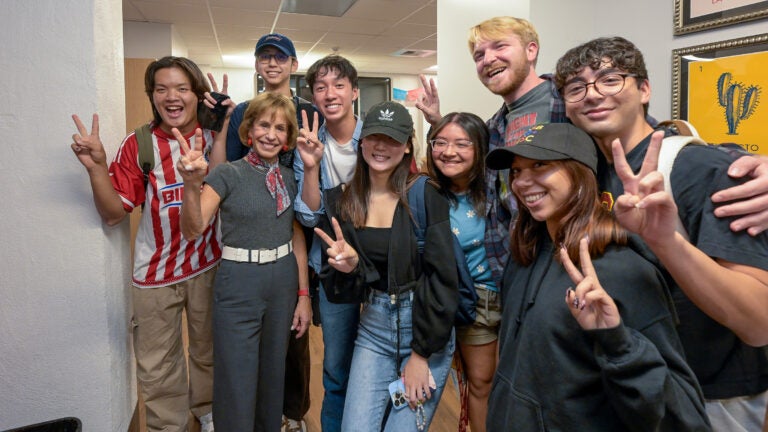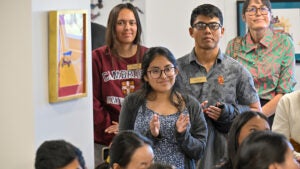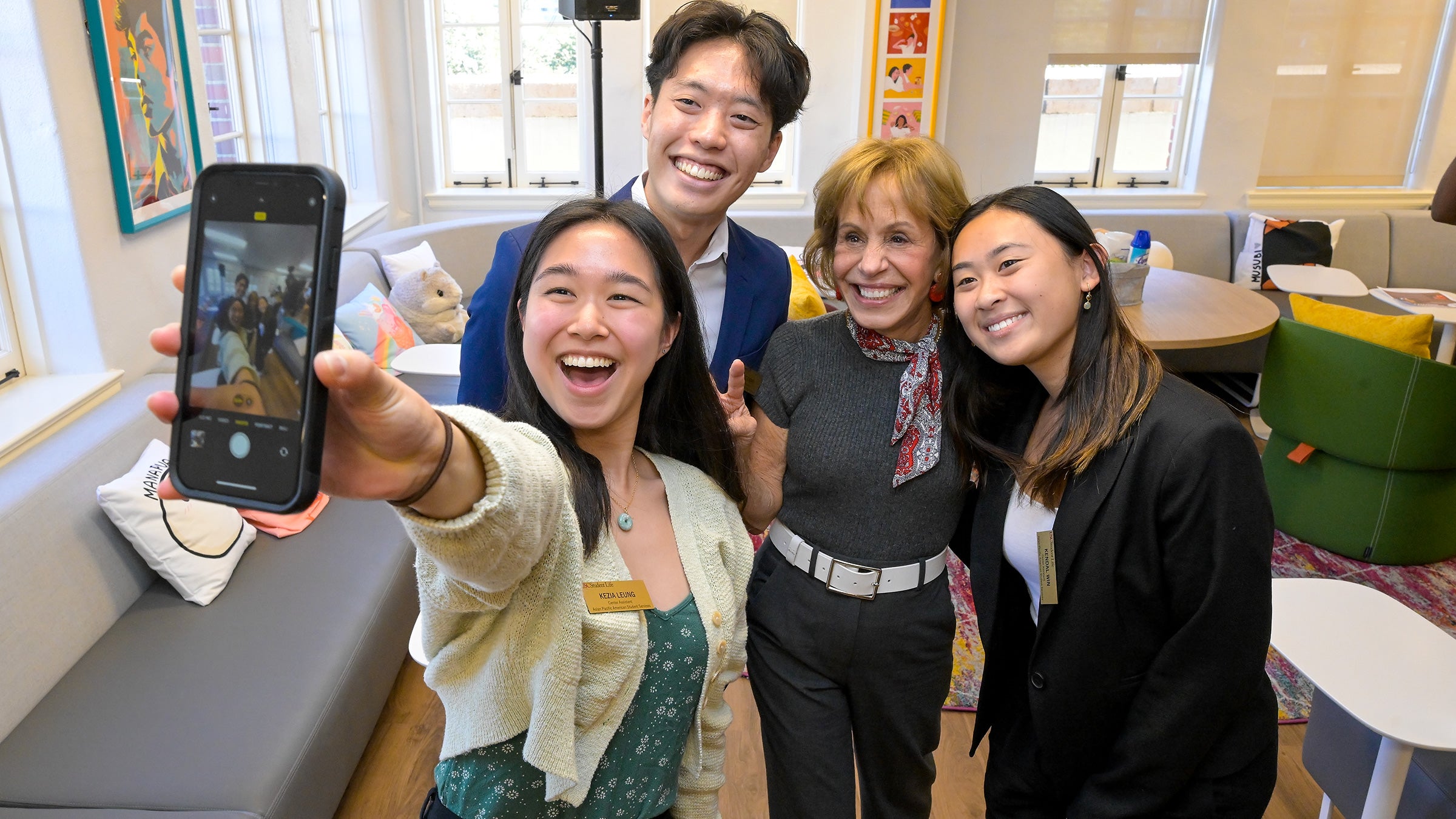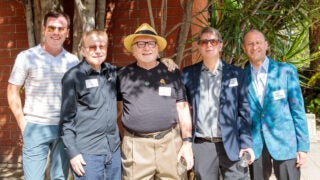
USC President Carol Folt takes some pictures with students during the reopening of Student Equity and Inclusion Programs’ facilities on the fourth floor of the Gwynn Wilson Student Union on Tuesday. (USC Photo/Gus Ruelas)
Jubilation fills Student Equity and Inclusion Programs spaces — now three times bigger — at reopening celebration
Trojans feel sense of belonging and support by spending time with each other in Student Union centers and lounges.
Standing in the bright, spacious room of the newly renovated Asian Pacific American Student Services Lounge on Tuesday, USC President Carol Folt reminded the hundreds of students, staff and faculty there that before this fall, they could never have gathered together to celebrate this way.
“We used to squeeze people together into one room, and you couldn’t get your arms up to say, ‘Fight On!’ at the end,” Folt said with a smile. “It was very, very tight. We needed bigger.”

The official grand reopening celebration of the dramatically expanded Student Equity and Inclusion Programs area on the fourth floor of the Gwynn Wilson Student Union building included music, refreshments and plenty of camaraderie and joy.
After a series of renovations, the spaces have been tripled in size from 5,000 to 15,000 square feet. The changes have resulted in less cluttered areas for APASS, La CASA, the LGBTQ+ Student Center and the Native American & Pasifika Student Lounge. Staff and students in these spaces present programs that acknowledge intersectionality and seek to create a sense of belonging and nurture well-being.
The improved student spaces are not only larger, but many are also now connected, with shared kitchens and meeting rooms paving the way for more interaction between the different student groups. Each area honors specific cultures and identities through artwork and other features, but all have one common design element: Stenciled on the wall of each in large letters are the words “You Belong at USC.”
“I would certainly say this is a moment when we have to find places that people can be together and find each other,” Folt said to the approximately 300 people at the launch event. “You can go from room to room and probably find a home in so many parts of this amazing center. That’s what students said they wanted to be able to do.”
Vice President for Student Life Monique S. Allard described the grand reopening of the multiple centers as “a momentous moment in our university’s history” and praised Folt’s leadership and dedication to diversity, equity, inclusion and belonging on campus.
“She is one of our champions and a real pleasure and privilege to work with,” Allard said. “We’re able to build an inclusive legacy for all of our students today and all the students in the decades to come.”
A growing demand for USC Student Equity and Inclusion Programs space
During the 2022-23 school year, visits to the APASS space surged by 33% to 4,300 visits. Summer renovation resulted in more than double the previous square footage for the space dedicated to the more than 40 ethnic groups that are included in the Asian and Pacific Islander community.

Phong Doozy, a graduate student at USC Price School of Public Policy, has been frequenting the APASS Lounge since his freshman year and was pleased to be on hand for the event.
“I think this is state-of-the-art,” he said of the renovated space. “This is a great place for students to learn from one another but to also have a safe place to do their homework and to collaborate on personal or academic goals as well. I’m very happy to be involved.”
Doozy said it has always been a part of his cultural upbringing as a Vietnamese American to stay connected with his community. He is glad to have found the opportunity to do so at USC.
“I think there’s no better place than to be involved with people who care so much about your cultural background, your academic achievement and success in your personal life,” he said.
Also doubled is the physical space for La CASA. The center had 5,500 visits during the last school year. The number is expected to grow during the current school year, with 20% of this fall’s first-year students identifying as Latino — a USC record.
Graduate students Stacy Castillo and Eliana Cotom of the USC Rossier School of Education are among those who frequent the space and attended the grand reopening.
“I come here all the time, and every time I make a new friend,” Castillo said. “People just like to talk, and it’s a nice feeling. It’s really been a great space for me.”
Cotom has been coming to La CASA since her undergraduate days at USC and said the space always seemed a bit crowded before the renovation. She is appreciative of the additional room to study and attend meetings and events.
“It’s a bit more walkable now,” she said. “I love seeing the colors, the couch space, the seats. If you want to take a nap and put your feet up, you can do that.”
Cotom added that it is important for Latino students at USC to be able to connect with their fellow students to “understand the struggles, have a sense of belonging, a sense of home.”
Connecting with community
The LGBTQ+ Student Center, which had more than 6,000 student visits last school year, has been expanded by another 300 square feet after previously growing by 300 square feet in 2021. The center hosts weekly affinity groups for a variety of identities and communities within the LGBTQ+ umbrella.
“It just feels like a breath of fresh air,” USC Rossier graduate student Izzy Batiste said during the open house. “When you have a space where everybody’s familiar with each other and goes through the same experiences, you can have conversations where you can really connect with people.”
Junior Cat Broderick of the USC Dornsife College of Letters, Arts and Sciences chatted with Folt during a tour of the newly located Native American & Pasifika Student Lounge. She shared how students come into the space to listen to traditional music, share a laugh “and be understood.”
“It’s essential that we have a space that’s safe for us to come together and to be in community where we can really be honest,” Broderick said. “I come in here every day and I see my best friends — I think that’s the way it is for everyone.”
Moves create more room for USC Student Equity and Inclusion Programs
The transformation of the building began during the early days of the COVID-19 pandemic in 2020 with the moving of the ticket office from the first floor of the Student Union over to the Galen Center. This enabled the Center for Black Cultural and Student Affairs to move from the fourth floor to the first and expand dramatically.
The additional space has been crucial since the center has seen its student visits grow from 500 per year pre-pandemic to 8,874 check-ins last year. The space also became home to the new Middle Eastern and North African (MENA) Student Lounge.
The move also paved the way for the addition of the First Generation Plus Success Center, which serves first-generation students, transfer students, former foster youth and undocumented students. The fall enrollment of first-year students had a USC record 26% first-generation students, while 28% of new transfer students are first-generation.
After speaking, Folt toured each of the renovated spaces and spoke with the students who frequently spend time there between classes and during free time.
“Students really expressed a greater sense of belonging,” she said. “That’s what we’re looking for in this world. That is what we all want and need to feel and when we do our best work.”



